Module 10 - Introduction to Wave Propagation, Transmission Lines, and Antennas
Pages i,
1-1,
1-11,
1-21,
1-31,
1-41,
2-1,
2-11,
2-21,
2-31,
2-40,
3-1,
3-11,
3-21,
3-31,
3-41,
3-51,
4-1,
4-11,
4-21,
4-31,
4-41,
4-51, Index

When you use the above equation, be careful to express velocity and wavelength in the proper
units of length. For example, in the English system, if the velocity (expressed in
feet per second) is divided by the frequency (expressed in cycles per second, or Hz),
the wavelength is given in feet per cycle. If the metric system is used and the
velocity (expressed in meters per second) is divided by the frequency (expressed in
cycles per second), the wavelength is given in meters per cycle. Be sure to express
both the wavelength and the frequency in the same units. (Feet per cycle and meters per cycle are normally
abbreviated as feet or meters because one wavelength indicates one cycle.) Because this equation holds true for
both transverse and longitudinal waves, it is used in the study of both electromagnetic waves and sound waves.
Consider the following example. Two cycles of a wave pass a fixed point every second, and the velocity of the
wave train is 4 feet per second. What is the wavelength? The formula for determining wavelength is as follows:
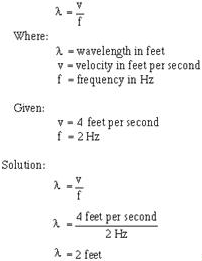
Note: In problems of this kind, be sure NOT to confuse wave velocity with frequency. Frequency is the
number of cycles per unit of time (Hz). WAVE VELOCITY is the
speed with which a wave train passes a fixed point.
Here is another problem. If a wave has a velocity of 1,100 feet per second and a wavelength of 30
feet, what is the frequency of the wave? By transposing the general equation:
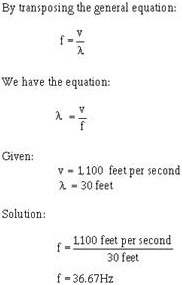
To find the velocity, rewrite the equation as:
v = λf Let's work one more problem, this time using the metric system. Suppose the wavelength is 0.4
meters and the frequency is 12 kHz. What is the velocity? use the formula:
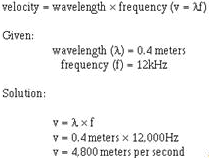
Other important characteristics of wave motion are reflection, refraction, diffraction, and the
Doppler effect. Big words, but the concept of each is easy to see. For ease of understanding, we will explain the
first two characteristics using light waves, and the last two characteristics using sound waves. You should keep
in mind that all waves react in a similar manner. Within mediums, such as air, solids, or gases, a wave
travels in a straight line. When the wave leaves the boundary of one medium and enters the boundary of a different
medium, the wave changes direction. For our purposes in this module, a boundary is an imaginary line that
separates one medium from another. When a wave passes through one medium and encounters a medium having
different characteristics, three things can occur to the wave: (1) Some of the energy can be reflected back into
the initial medium; (2) some of the energy can be transmitted into the second medium where it may continue at a
different velocity; or (3) some of the energy can be absorbed by the medium. In some cases, all three processes
(reflection, transmission, and absorption) may occur to some degree. Reflection
REFLECTION WAVES are simply waves that are neither transmitted nor absorbed, but are reflected from the surface of
the medium they encounter. If a wave is directed against a reflecting surface, such as a mirror, it will reflect
or "bounce" from the mirror. Refer to figure 1-9. a wave directed toward the surface of the mirror is called the
INCIDENT wave. When the wave bounces off of the mirror, it becomes known as the REFLECTED wave. An imaginary line
perpendicular to the mirror at the point at which the incident wave strikes the mirror's surface is called the
NORMAL, or perpendicular. The angle between the incident wave and the normal is called the ANGLE of INCIDENCE. The
angle between the reflected wave and the normal is called the ANGLE of REFLECTION.
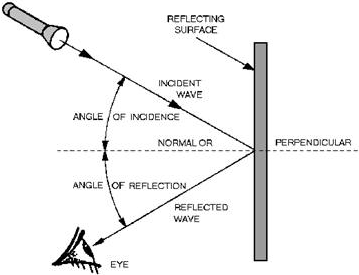
Figure 1-9. - Reflection of a wave.
If the reflecting surface is smooth and polished, the angle between the incident ray and the normal
will be the same as the angle between the reflected ray and the normal. This conforms to the law of reflection
which states:
The angle of incidence is equal to the angle of reflection. The amount of
incident wave energy reflected from a given surface depends on the nature of the surface and the angle at which
the wave strikes the surface. As the angle of incidence increases, the amount of wave energy reflected increases.
The reflected energy is the greatest when the wave is nearly parallel to the reflecting surface. When the incident
wave is perpendicular to the surface, more of the energy is transmitted into the substance and less is reflected.
At any incident angle, a mirror reflects almost all of the wave energy, while a dull, black surface reflects very
little.
Q11. What is the law of reflection? Q12. When a wave is reflected from a surface, energy is
transferred. When is the transfer of energy greatest? Q13. When is the transfer of energy minimum?
Refraction When a wave passes from one medium into another medium that has a different velocity of
propagation, a change in the direction of the wave will occur. This changing of direction as the wave enters the
second medium is called REFRACTION. As in the discussion of reflection, the wave striking the boundary (surface)
is called the INCIDENT WAVE, and the imaginary line perpendicular to the boundary is called the NORMAL. The angle
between the incident wave and the normal is called the ANGLE of INCIDENCE. As the wave passes through the
boundary, it is bent either toward or away from the normal. The angle between the normal and the path of the wave
through the second medium is the ANGLE of REFRACTION. A light wave passing through a block of glass is
shown in figure 1-10. The wave moves from point a to B at a constant speed. This is the incident wave. As the wave
penetrates the glass boundary at point B, the velocity of the wave is slowed down. This causes the wave to bend
toward the normal. The wave then takes the path from point B to C through the glass and becomes BOTH the refracted
wave from the top surface and the incident wave to the lower surface. As the wave passes from the glass to the air
(the second boundary), it is again refracted, this time away from the normal and takes the path from point C to D.
As the wave passes through the last boundary, its velocity increases to the original velocity. As figure 1-10
shows, refracted waves can bend toward or away from the normal. This bending depends on the velocity of the wave
through each medium. The broken line between points B and E is the path that the wave would travel if the two
mediums (air and glass) had the same density.
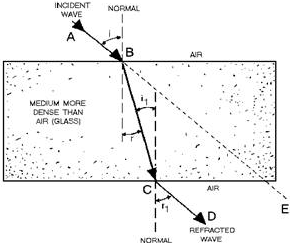
Figure 1-10. - Refraction of a wave. To summarize what figure 1-10 shows: 1. If the wave passes from a less dense medium to a more
dense medium, it is bent toward the normal, and the angle of refraction (r) is less than the angle of incidence
(i). 2. If the wave passes from a more dense to a less dense medium, it is bent away from the normal,
and the angle of refraction (r1) is greater than the angle of incidence (i1).
You can more easily understand refraction by looking at figure 1-11. There is a plowed field in the middle of a
parade ground. Think of the incident wave as a company of recruits marching four abreast at an angle across the
parade ground to the plowed field, then crossing the plowed field and coming out on the other side onto the parade
ground again. As the recruits march diagonally across the parade ground and begin to cross the boundary onto the
plowed field, the front line is slowed down. Because the recruits arrive at the boundary at different times, they
will begin to slow down at different times (number 1 slows down first and number 4 slows down last in each line).
The net effect is a bending action. When the recruits leave the plowed field and reenter the parade ground, the
reverse action takes place.

Figure 1-11. - Analogy of refraction. Q14. a refracted wave occurs when a wave passes from one medium into another medium. What determines
the angle of refraction? Diffraction DIFFRACTION is the bending of the wave path
when the waves meet an obstruction. The amount of diffraction depends on the wavelength of the wave. Higher
frequency waves are rarely diffracted in the normal world that surrounds us. Since light waves are high frequency
waves, you will rarely see light diffracted. You can, however, observe diffraction in sound waves by listening to
music. Suppose you are outdoors listening to a band. If you step behind a solid obstruction, such as a brick wall,
you will hear mostly low notes. This is because the higher notes, having short wave lengths, undergo little or no
diffraction and pass by or over the wall without wrapping around the wall and reaching your ears. The low notes,
having longer wavelengths, wrap around the wall and reach your ears. This leads to the general statement that
lower frequency waves tend to diffract more than higher frequency waves. Broadcast band (AM band) radio waves
(lower frequency waves) often travel over a mountain to the opposite side from their source because of
diffraction, while higher frequency TV and FM signals from the same source tend to be stopped by the mountain.
Doppler Effect
The last, but equally important, characteristic of a wave that we will discuss is the Doppler effect. The DOPPLER
EFFECT is the apparent change in frequency or pitch when a sound source moves either toward or away from the
listener, or when the listener moves either toward or away from the sound source. This principle, discovered by
the Austrian physicist Christian Doppler, applies to all wave motion. The apparent change in frequency
between the source of a wave and the receiver of the wave is because of relative motion between the source and the
receiver. To understand the Doppler effect, first assume that the frequency of a sound from a source is held
constant. The wavelength of the sound will also remain constant. If both the source and the receiver of the sound
remain stationary, the receiver will
hear the same frequency sound produced by the source. This is because the receiver is receiving the
same number of waves per second that the source is producing. Now, if either the source or the receiver or both
move toward the other, the receiver will perceive a higher
frequency
sound. This is because the receiver will receive a greater number of sound waves per second and interpret the
greater number of waves as a higher frequency sound. Conversely, if the source and the receiver are
moving apart, the receiver will receive a smaller number of sound waves per second and will
perceive a lower frequency sound. In both cases, the
frequency of the sound produced by the source will have remained constant. For example, the frequency of
the whistle on a fast-moving train sounds increasingly higher in pitch as the train is approaching than when the
train is departing. Although the whistle is generating sound waves of a constant frequency, and though they travel
through the air at the same velocity in all directions, the distance between the approaching train and the
listener is decreasing. As a result, each wave has less distance to travel to reach the observer than the wave
preceding it. Thus, the waves arrive with decreasing intervals of time between them. These apparent
changes in frequency, called the Doppler effect, affect the operation of equipment used to detect and measure wave
energy. In dealing with electromagnetic wave propagation, the Doppler principle is used in equipment such as
radar, target detection, weapons control, navigation, and sonar. Q15. The apparent change in frequency
or pitch because of motion is explained by what effect?
SOUND WAVES The study of sound is important because of the role sound plays in the depth finding equipment
(fathometer) and underwater detection equipment (sonar) used by the Navy. As you know, sound travels
through a medium by wave motion. Although sound waves and the electromagnetic waves used in the propagation of
radio and radar differ, both types of waves have many of the same characteristics. Studying the principles of
sound-wave motion will help you understand the actions of both sound waves and the more complex radio and radar
electromagnetic waves. The major differences among sound waves, heat waves, and light waves are (1) their
frequencies; (2) their types; the mediums through which they travel; and the velocities at which they travel.
SOUND - What Is IT?
The word SOUND is used in everyday speech to signify a variety of things. One definition of sound is the sensation
of hearing. Another definition refers to a stimulus that is capable of producing the sensation of hearing. a third
definition limits sound to what is actually heard by the human ear. In the study of physics, sound is
defined as a range of compression-wave frequencies to which the human ear is sensitive. For the purpose of this
chapter, however, we need to broaden the definition of sound to include compression waves that are not always
audible to the human ear. To distinguish frequencies in the audible range from those outside that range, the words
SONIC, ULTRASONIC, and INFRASONIC are used. Sounds capable of being heard by the human ear are called SONICS. The
normal hearing range extends from about 20 to 20,000 hertz. However, to establish a standard sonic range, the Navy
has set an arbitrary upper limit for sonics at 10,000 hertz and a lower limit at 15 hertz. Even though the average
person can hear sounds above 10,000 hertz, it is standard practice to refer to sounds above that frequency as
ultrasonic. Sounds between 15 hertz and 10,000 hertz are called sonic, while sounds below 15 hertz are known as
infrasonic (formerly referred to as subsonic) sounds.
Q16. What term describes sounds capable of being heard by the human ear? Q17. Are all
sounds audible to the human ear? Why? REQUIREMENTS for SOUND Recall that sound
waves are compression waves. The existence of compression waves depends on the transfer of energy. To produce
vibrations that become sounds, a mechanical device (the source) must first receive an input of energy. Next, the
device must be in contact with a medium that will receive the sound energy and carry it to a receiver. If the
device is not in contact with a medium, the energy will not be transferred to a receiver, and there will be no
sound.
Thus, three basic elements for transmission and reception of sound must be present before a sound can be produced.
They are (1) the source (or transmitter), (2) a medium for carrying the sound (air, water, metal, etc.), and (3)
the detector (or receiver). A simple experiment provides convincing evidence that a medium must be present
if sound is to be transferred. In figure 1-12, an electric bell is suspended by rubber bands in a bell jar from
which the air can be removed. An external switch is connected from a battery to the bell so the bell may be rung
intermittently. As the air is pumped out, the sound from the bell becomes weaker and weaker. If a perfect vacuum
could be obtained, and if no sound were conducted out of the jar by the rubber bands, the sound from the bell
would be completely inaudible. In other words, sound cannot be transmitted through a vacuum. When the air is
admitted again, the sound is as loud as it was at the beginning. This experiment shows that when air is in contact
with the vibrating bell, it carries energy to the walls of the jar, which in turn are set in vibration. Thus, the
energy passes into the air outside of the jar and then on to the ear of the observer. This experiment illustrates
that sound cannot exist in empty space (or a vacuum).
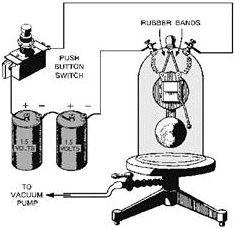
Figure 1-12. - No air, no sound. Any object that moves rapidly back and forth, or vibrates, and thus disturbs the medium around it may be
considered a source for sound. Bells, speakers, and stringed instruments are familiar sound sources.
The material through which sound waves travel is called the medium. The density of the medium
determines the ease, distance, and speed of sound transmission. The higher the density of the medium, the slower
sound travels through it. The detector acts as the receiver of the sound wave. Because it does not
surround the source of the sound wave, the detector absorbs only part of the energy from the wave and sometimes
requires an amplifier to boost the weak signal. As an illustration of what happens if one of these three
elements is not present, let's refer to our experiment in which a bell was placed in a jar containing a vacuum.
You could see the bell being struck, but you could hear no sound because there was no medium to transmit sound
from the bell to you. Now let's look at another example in which the third element, the detector, is missing. You
see a source (such as an explosion) apparently producing a sound, and you know the medium (air) is present, but
you are too far away to hear the noise. Thus, as far as you are concerned, there is no detector and, therefore, no
sound. We must assume, then, that sound can exist only when a source transmits sound through a medium, which
passes it to a detector. Therefore, in the absence of any one of the basic elements (source, medium, detector)
there can be NO sound. Q18. Sound waves transmitted from a source are sometimes weak when they reach the
detector. What instrument is needed to boost the weak signal? TERMS useD IN SOUND WAVES
Sound waves vary in length according to their frequency. a sound having a long wavelength is heard at a
low pitch (low frequency); one with a short wavelength is heard at a high pitch
(high frequency). a complete wavelength is called a cycle. The distance from one point on a wave to the
corresponding point on the next wave is a
wavelength. The number of cycles per second (hertz) is the frequency of the sound.
The
frequency of a sound wave is also the number of vibrations
per second produced by the sound source. Q19. What are the three basic requirements for sound?
Characteristics of SOUND Sound waves travel at great distances in a very short time, but
as the distance increases the waves tend to spread out. As the sound waves spread out, their energy simultaneously
spreads through an increasingly larger area. Thus, the wave energy becomes weaker as the distance from the source
is increased. Sounds may be broadly classified into two general groups. One group is NOIsE, which includes
sounds such as the pounding of a hammer or the slamming of a door. The other group is musical sounds, or TONES.
The distinction between noise and tone is based on the regularity of the vibrations, the degree of damping, and
the ability of the ear to recognize components having a musical sequence. You can best understand the physical
difference between these kinds of sound by comparing the waveshape of a musical note, depicted in view a of figure
1-13, with the waveshape of noise, shown in view B. You can see by the comparison of the two waveshapes, that
noise makes a very irregular and haphazard curve and a musical note makes a uniform and regular curve.
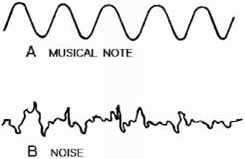
Figure 1-13. - Musical sound versus noise. Sound has three basic characteristics: pitch, intensity, and quality. Each of these three
characteristics is associated with one of the properties of the source or the type of waves which it produces. The
pitch depends upon the frequency of the waves; the intensity depends upon the amplitude of the waves; and the
quality depends upon the form of the waves. With the proper combination of these characteristics, the tone is
pleasant to the ear. With the wrong combination, the sound quality turns into noise. The Pitch of
Sound
The term PITCH is used to describe the frequency of a sound. An object that vibrates many times per second
produces a sound with a high pitch, as with a police whistle. The slow vibrations of the heavier strings of a
violin cause a low-pitched sound. Thus, the frequency of the wave determines pitch. When the frequency is low,
sound waves are long; when it is high, the waves are short. a sound can be so high in frequency that the waves
reaching the ear cannot be heard. Likewise, some frequencies are so low that the eardrums do not convert them into
sound. The range of sound that the human ear can detect varies with each individual. The Intensity
of Sound
The intensity of sound, at a given distance, depends upon the amplitude of the waves. Thus, a tuning fork gives
out more energy in the form of sound when struck hard than when struck gently. You should remember that when a
tuning fork is struck, the sound is omnidirectional (heard in all directions), because the sound waves spread out
in all directions, as shown in figure 1-14. You can see from the figure that as the distance between the waves and
the sound source increases, the energy in each wave spreads over a greater area; hence, the intensity of the sound
decreases. The speaking tubes sometimes used aboard a ship prevent the sound waves from spreading in all
directions by concentrating them in one desired direction (unidirectional), producing greater intensity.
Therefore, the sound is heard almost at its original intensity at the opposite end of the speaking tube. The
unidirectional megaphone and the directional loudspeaker also prevent sound waves from spreading in all
directions.
| - |
Matter, Energy,
and Direct Current |
| - |
Alternating Current and Transformers |
| - |
Circuit Protection, Control, and Measurement |
| - |
Electrical Conductors, Wiring Techniques,
and Schematic Reading |
| - |
Generators and Motors |
| - |
Electronic Emission, Tubes, and Power Supplies |
| - |
Solid-State Devices and Power Supplies |
| - |
Amplifiers |
| - |
Wave-Generation and Wave-Shaping Circuits |
| - |
Wave Propagation, Transmission Lines, and
Antennas |
| - |
Microwave Principles |
| - |
Modulation Principles |
| - |
Introduction to Number Systems and Logic Circuits |
| - |
- Introduction to Microelectronics |
| - |
Principles of Synchros, Servos, and Gyros |
| - |
Introduction to Test Equipment |
| - |
Radio-Frequency Communications Principles |
| - |
Radar Principles |
| - |
The Technician's Handbook, Master Glossary |
| - |
Test Methods and Practices |
| - |
Introduction to Digital Computers |
| - |
Magnetic Recording |
| - |
Introduction to Fiber Optics |
| Note: Navy Electricity and Electronics Training
Series (NEETS) content is U.S. Navy property in the public domain. |
|

















